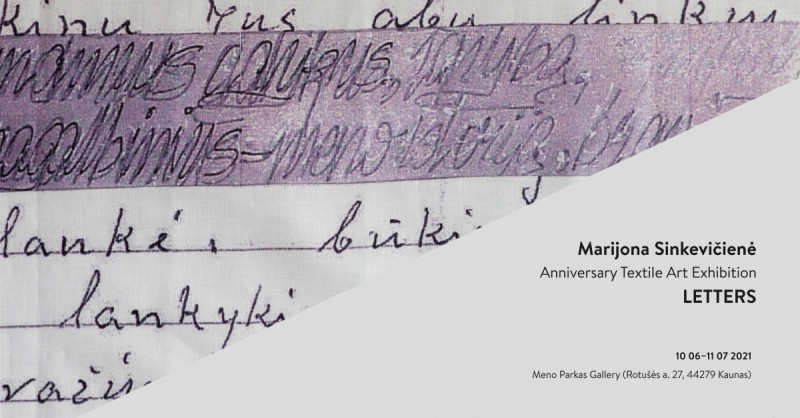The project “Letters” is the third part of ongoing project “Resurrected to Being”, which consisting of a total of three parts: “Resurrected to Being”, “Memory” (Dedicated to commemorate the centenary of the Restoration of the Lithuanian State) and “Letters”.
I was motivated to present this idea in a form of textile works, by the distance of society from letters written by hand, in other words a calligraphic manuscript with its own deep history. Looking back, we see that the information that people wanted to convey to each other, came in parallel with human history. The oldest preserved historical documents are calligraphic manuscripts. Through the historical heritage of writing, we have the opportunity to see ancient characters, to read the facts of the history of that time from ancient times to the present day. Calligraphy is the art of beautiful writing or a penmanship that is applicable in many areas. The story of writing, the search for new styles, just beautiful handwriting or a personal author’s signature. Sometimes, the content itself is not that important or meaningful, maybe the whole point is in form. When we look at a text, we take it as for something to be read, rarely as something to be looked at. The author’s handwriting, the shapes of letters, writing style, says a lot about the person who writes the letter. It is unique, authorial, sometimes difficult to replicate by another person. Both text and handwriting are equally important in the sender’s manuscript.
Letters are very dear to me in every sense. I still keep those addressed to me. Through them, I look at the time that has passed since the letters were written, I see how the person’s handwriting and text has changed. I think we have all written the very first letter, but over the years, there is also the last letter. They are all very precious and important because they speak of our presence in this world.
The main concept of textile works “Letters” is the importance and significance of a written letter from person to person. There is a huge difference between a letter written in Times New Roman font, where the font of all authors ’letters is the same, and the personal handwriting of each author. The conceptual works of the collection symbolize the journey of a letter through human life, the passing of information, communication, from generation to generation, from the past to the present and resurrected to being, to the present.
The aim of this creative work is to draw the public’s attention to the passing of information, communication by writing letters in author’s handwriting, which captures our emotions, feelings, experiences with unique personal calligraphy. Letters written by hand are the language of the soul and heart.
By no means do I deny modern forms of communication: by e-mails, mobile phones and other means of efficiency, which allow us to communicate with loved ones at any moment while in another part of the world. But by not writing the letters by hand and not receiving them ourselves, we lose something very peculiar and subtle, after all, the letter, in a sense, is like a physical touch of a loved one.
The collection of textile works “Letters” consists of artworks created by photo textile, tapestry and embroidery techniques. In this cycle, modern technologies are used, combining them with classical textile techniques.
– Artist Marijona Sinkevičienė
Textile artist Marijona Sinkevičienė was born in 1951 in Tauragė district, currently lives and works in Kaunas. In 1982 she graduated from Vilnius Academy of Arts, gained textile specialty. She worked as an associate professor. Since 1987 is a member of Lithuanian Artists‘ Association. She is a member of textile art group “Esame”. Participating in international and group exhibitions in Lithuania and abroad. Her works are in collections of the Polish Museum of Art in Gdynia, Krosna, Lithuania, and the Raseiniai Regional Museum (Lithuania). The author has created a textile works for the National Kaunas Drama Theater (1986), a tapestry cycle “Seasons” for the kindergarten of Slavičius in Ukraine (1987).
Exhibition is financed by the Lithuanian Council for Culture and Lithuanian Artists‘ Association.
Gallery name: Meno Parkas Gallery
Address: Rotušės a. 27, Kaunas
Opening hours: Tue-Fri 11:00 - 18:30, Sat 11:00 - 16:00
Open: 10.06.2021 - 11.07.2021







